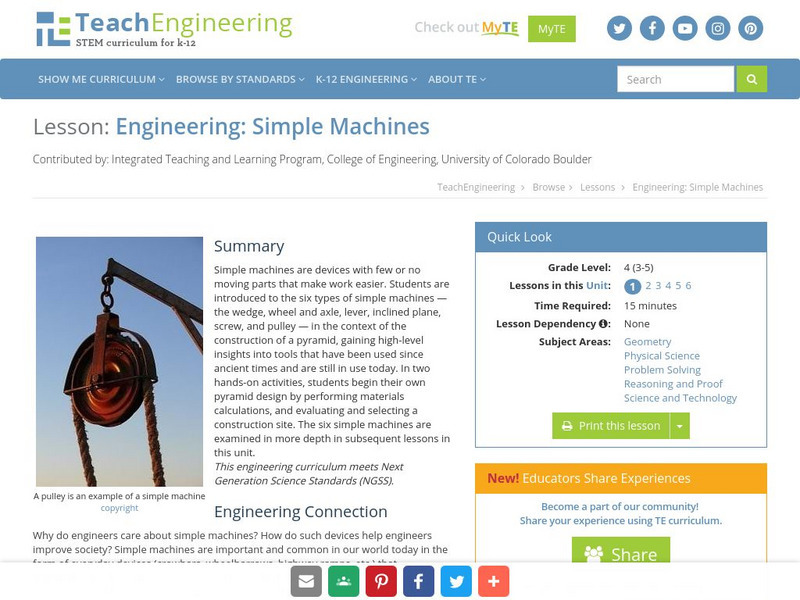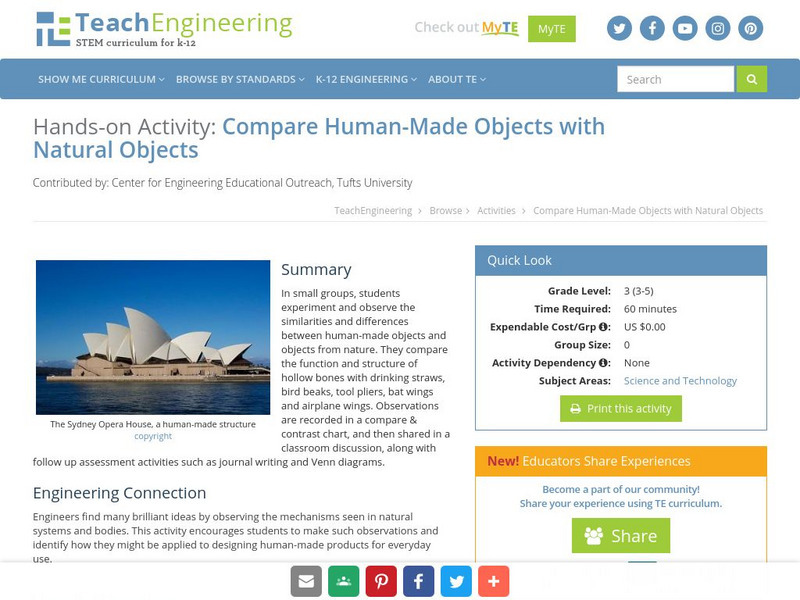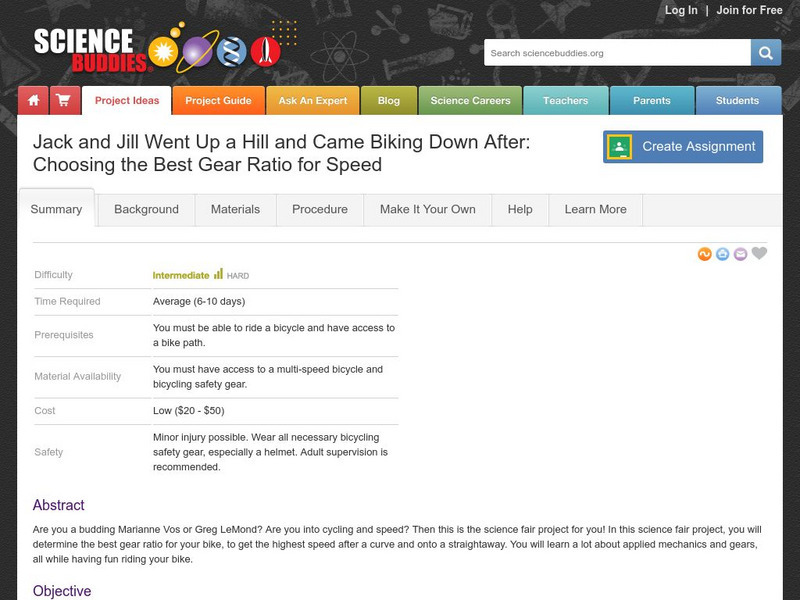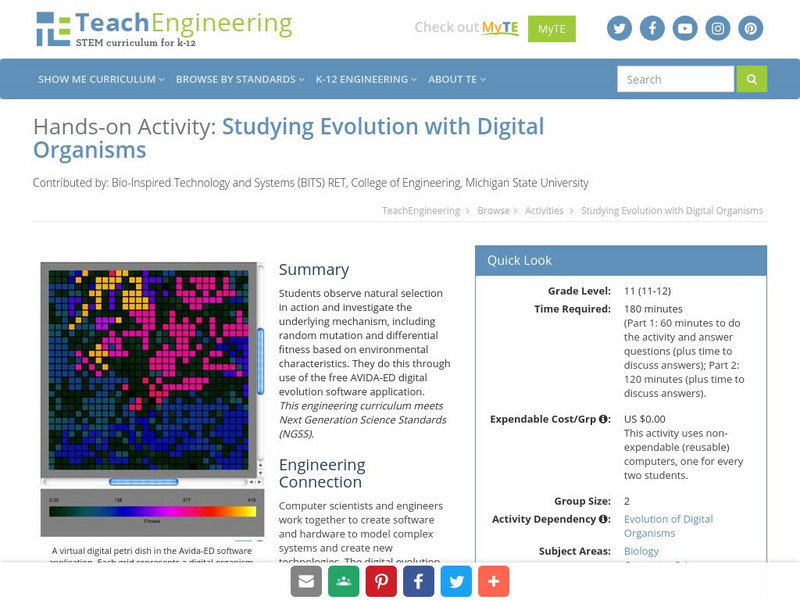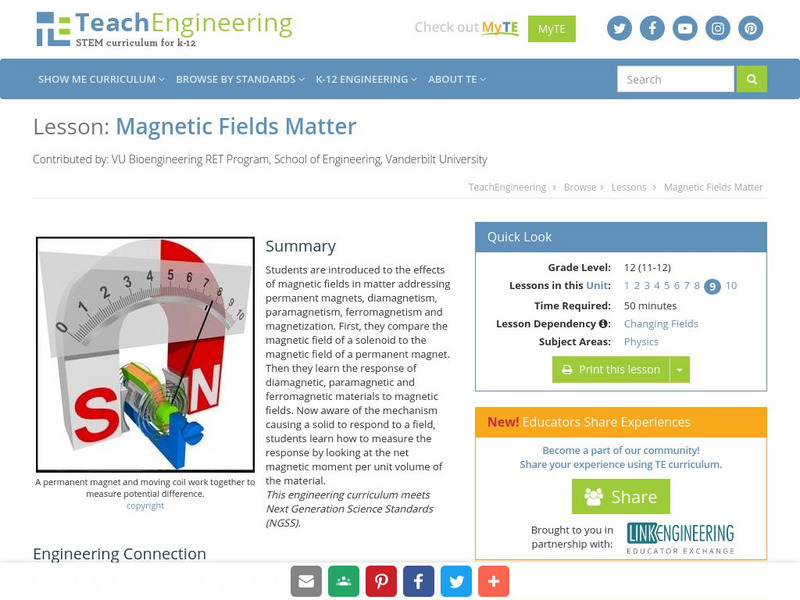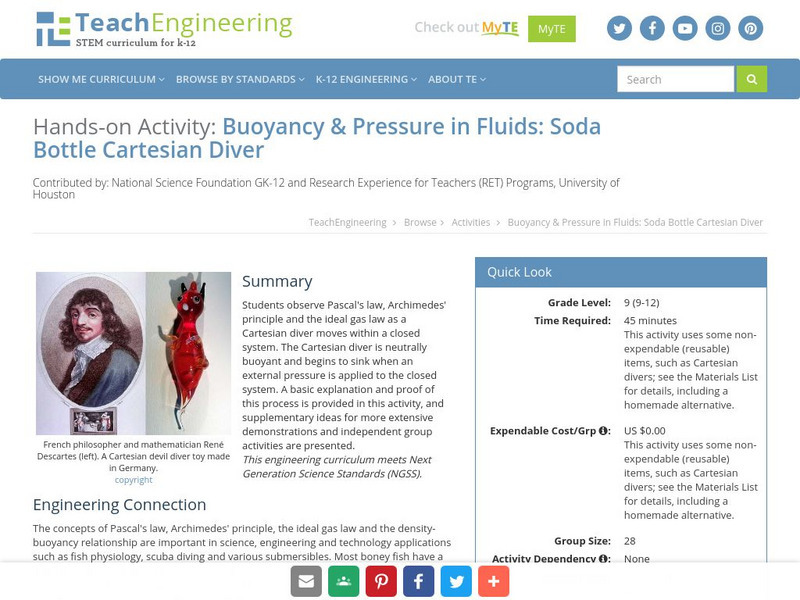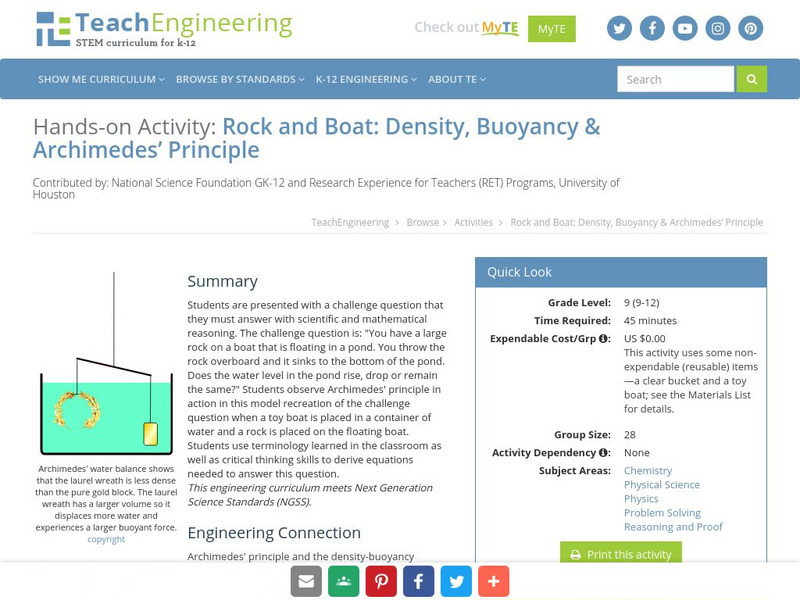TeachEngineering
Teach Engineering: Spin Me a Story
In a spin-off to studying about angular momentum, students use basic methods of comparative mythology to consider why spinning and weaving are common motifs in creation myths and folktales. Note: The literacy activities for the Mechanics...
TeachEngineering
Teach Engineering: Swinging on a String
Students explore how pendulums work and why they are useful in everyday applications. In a hands-on activity, they experiment with string length, pendulum weight and angle of release. In an associated literacy activity, students explore...
Other
Ontario Council for Technology Education: Designing and Testing a Crane [Pdf]
By the end of this project, students will be familiar with the 6 different simple machines and will be able to identify how these machines are used in products and tools they use on a daily basis. They will investigate how mechanical...
TeachEngineering
Teach Engineering: Rube Goldberg and the Meaning of Machines
Simple and compound machines are designed to make work easier. When we encounter a machine that does not fit this understanding, the so-called machine seems absurd. In this instructional activity, the cartoons of Rube Goldberg are...
TeachEngineering
Teach Engineering: Engineering: Simple Machines
Simple machines are devices with few or no moving parts that make work easier. Learners are introduced to the six types of simple machines - the wedge, wheel and axle, lever, inclined plane, screw, and pulley - in the context of the...
TeachEngineering
Teach Engineering: Compare Human Made Objects With Natural Objects
In small groups, students will experiment and observe the similarities and differences between human-made objects and nature. The students will compare the function and structure of hollow bones with drinking straws, bird beaks, tool...
Science Buddies
Science Buddies: Jack and Jill Went Up a Hill and Came Biking Down After
Are you a budding Lance Armstrong or Greg LeMond? Are you into cycling and speed? Then this is the science fair project for you. In this science fair project, you will determine the best gear ratio for your bike, to get the highest speed...
Science Buddies
Science Buddies: Project Ideas: Transferring Heat by Convection in a Tank
In this engineering science fair project, students will determine the most effective method for quickly raising the temperature of a liquid in a tank. The Science Buddies project ideas are set up consistently beginning with an abstract,...
TeachEngineering
Teach Engineering: Energy Conversions
Students evaluate various everyday energy conversion devices and draw block flow diagrams to show the forms and states of energy into and out of the device. They also identify the forms of energy that are useful and the desired output of...
TeachEngineering
Teach Engineering: Studying Evolution With Digital Organisms
Students observe natural selection in action and investigate the underlying mechanism, including random mutation and differential fitness based on environmental characteristics. They do this through use of the free AVIDA-ED digital...
TeachEngineering
Teach Engineering: Magnetic Fields Matter
This instructional activity introduces students to the effects of magnetic fields in matter addressing permanent magnets, diamagnetism, paramagnetism, ferromagnetism, and magnetization. First students must compare the magnetic field of a...
TeachEngineering
Teach Engineering: Laser Types and Uses
Through two classroom demos, students are introduced to the basic properties of lasers through various mediums. In the Making an Electric Pickle demonstration, students see how cellular tissue is able to conduct electricity, and how this...
Discovery Education
Discovery Education: 3 M Young Scientist Lab: Salt Engineering
Salt crystals demonstrate how forces can be directed in mechanical systems.
Cosmo Learning
Cosmo Learning: Mechanics of Solids
A collection of video lectures from a course introducing students to the mechanics of solids. Webpage includes forty-one lectures from a professor at the National Programme on Technology Enhanced Learning. Lectures vary in length and...
Science Buddies
Science Buddies: The Unconstrained Truth About Constrained Layer Damping
This science fair project shows you how to transform a noisy piece of metal into a sound-muffling constrained-layer damper. You will record the sound of a controlled impact on a piece of metal with a microphone, a computer, and some free...
Science Buddies
Science Buddies: Time Is Money
By applying principles of industrial engineering and time management, you will learn how you can speed through your chores and still have time to kick back and relax. You will also learn that time-efficiency is not the only factor...
TeachEngineering
Teach Engineering: Flying With Style
As students begin to understand the physics behind thrust, drag, and gravity and how these relate these to Newton's three laws of motion, groups assemble and launch the rockets that they designed in the associated lesson.
TeachEngineering
Teach Engineering: A Shot Under Pressure
Students use their understanding of projectile physics and fluid dynamics to find the water pressure in water guns. By measuring the range of the water jets, they are able to calculate the theoretical pressure. Students create graphs to...
TeachEngineering
Teach Engineering: Measuring Viscosity
Students calculate the viscosity of various household fluids by measuring the amount of time it takes marble or steel balls to fall given distances through the liquids. They experience what viscosity means, and also practice using...
TeachEngineering
Teach Engineering: Cartesian Diver
Students observe Pascal's law, Archimedes' principle, and the ideal gas law as a Cartesian diver moves within a closed system.
TeachEngineering
Teach Engineering: What Are Newton's Laws?
Through a series of three lessons and one activity, students are introduced to inertia, forces, and Newton's three laws of motion.
TeachEngineering
Teach Engineering: Rock and Boat
Students observe Archimedes' principle in action in this challenge where a toy boat is placed in a container of water and a rock is placed on the floating boat. Students must explain why the water level rises/falls/stays the same based...
Other
Engine Science: Volumetric Efficiency
This page discusses the science and mechanics involved in the operation of a basic four stroke engine.
Science Struck
Science Struck: A Beginner's Guide: How Does a Hydraulic Motor Work?
Learn the mechanics behind how a hydraulic motor works, some different types of hydraulic motors, and their applications in industry.




![Ontario Council for Technology Education: Designing and Testing a Crane [Pdf] Lesson Plan Ontario Council for Technology Education: Designing and Testing a Crane [Pdf] Lesson Plan](https://d15y2dacu3jp90.cloudfront.net/images/attachment_defaults/resource/large/FPO-knovation.png)

